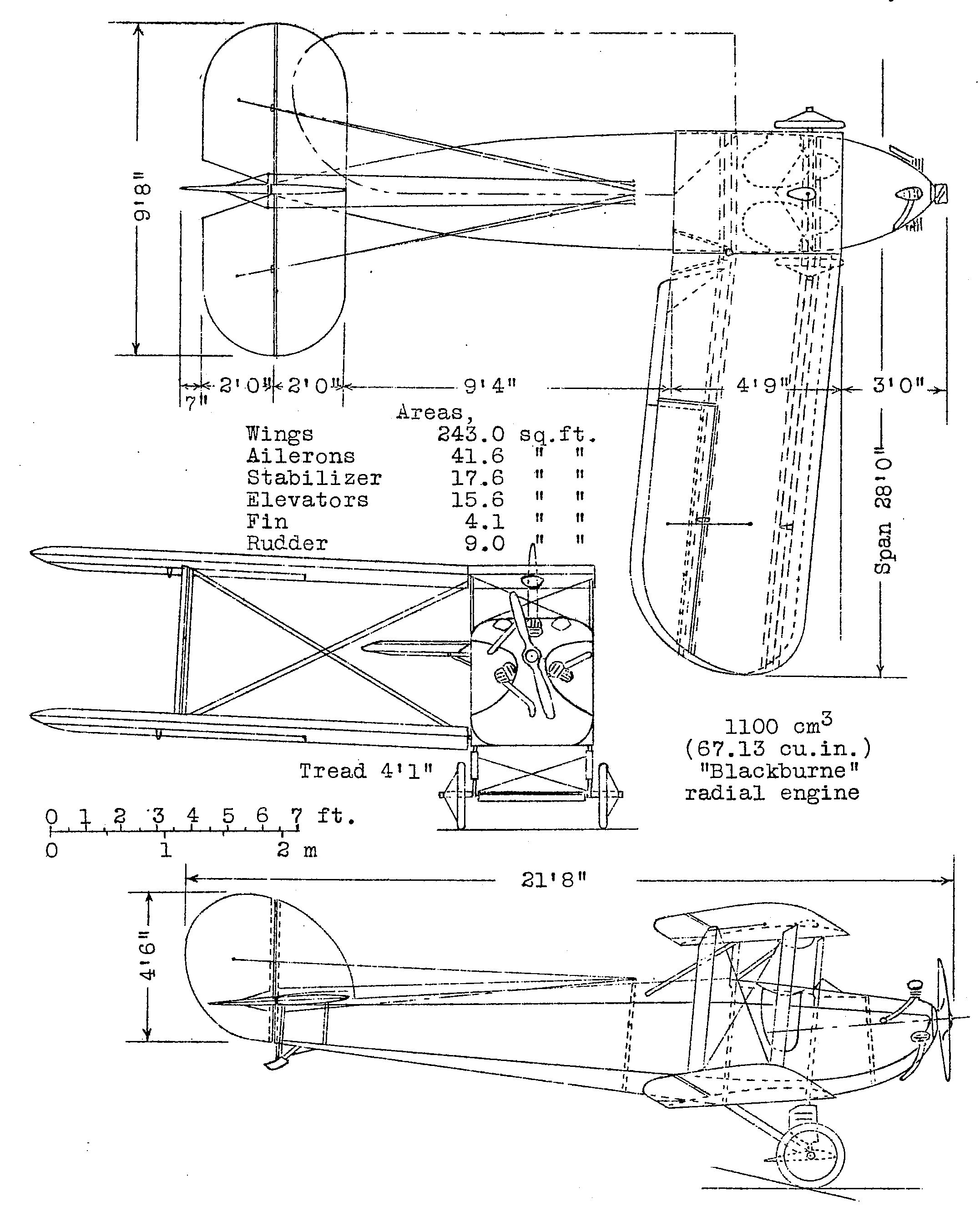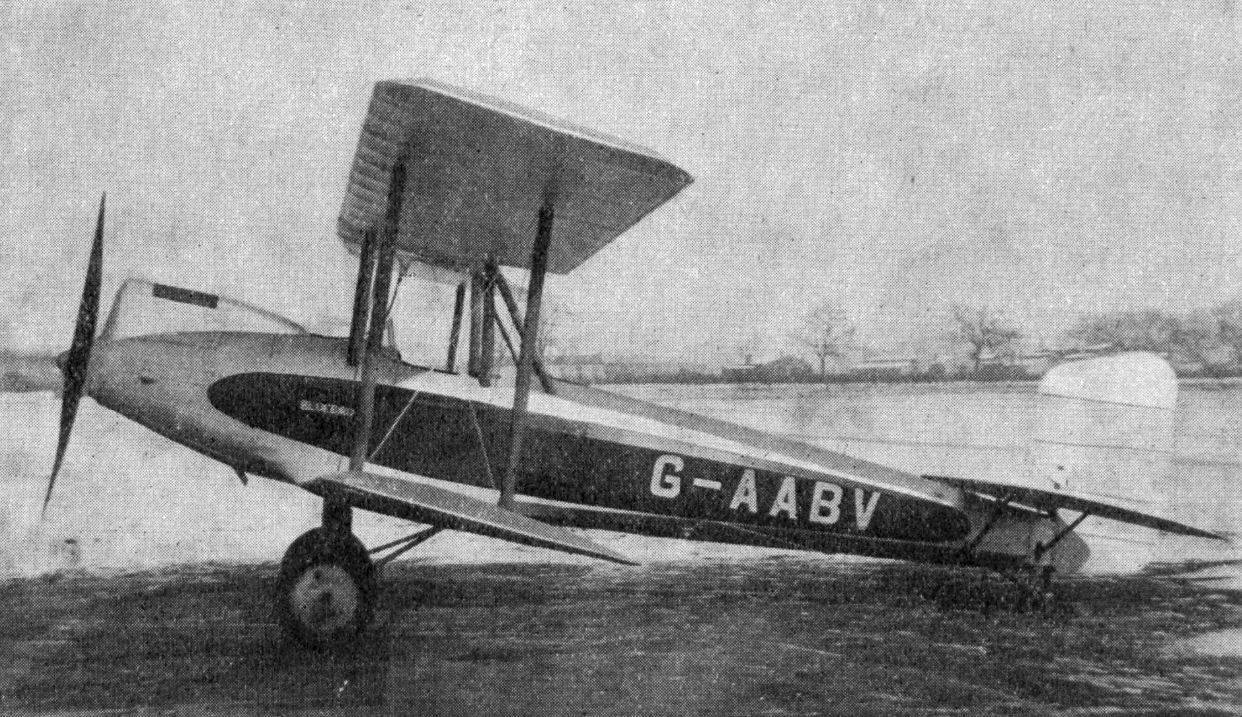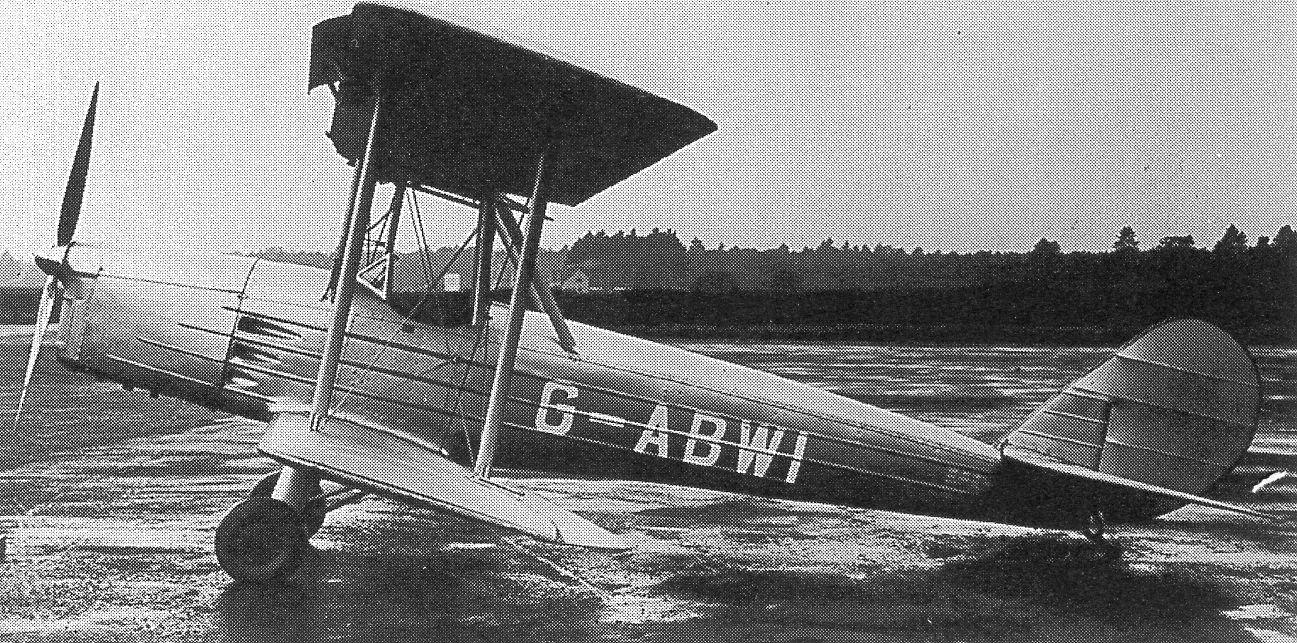|
Blackburn Bluebird
The Blackburn L.1 Bluebird was a British single-engine biplane light trainer/tourer with side-by-side seating, built in small numbers by Blackburn Aircraft in the 1920s. Design and development The Bluebird L.1 was initially designed as a competitor in the Lympne light aircraft trials to be held in September 1924 for a low-powered two-seater, fitted with a 67 in³ (1,100 cc) Blackburne Thrush three-cylinder radial engine. The Bluebird was a wooden single-bay biplane, with folding wings and was fitted with a single side-by-side cockpit.Jackson 1974, p. 208. Although first flying in 1924,Taylor 1989, p. 157 problems with the engine, which failed to give the expected power, meant that it could not compete in the 1924 competition.Jackson 1968, pp. 190–191. It was realised that the machines that resulted from the 1923 and 1924 light aircraft trials were too low-powered for serious use. The Daily Mail sponsored a similar competition in September 1926, this time allowin ... [...More Info...] [...Related Items...] OR: [Wikipedia] [Google] [Baidu] |
Blackburn Bluebird IV
The Blackburn Bluebird IV was a single-engine biplane light trainer/tourer biplane with side-by-side seating designed by the British aviation manufacturer Blackburn Aircraft. It was an all-metal development of the wooden Blackburn Bluebird I, II and III aircraft. The Blackburn IV was developed as a refinement of the preceding members of the Bluebird series; in addition to its all-metal airframe, it was noticeably more streamlined and its structure was simplified as to more readily facilitate its construction. Individual areas such as the tail unit and undercarriage were extensively revised. Conventional controls were used wherever practical. The Bluebird IV was a larger and heavier aircraft than its predecessors and could be fitted with various engines as standard, such as the de Havilland Gipsy, ADC Cirrus, and Cirrus Hermes. The first prototype performed its maiden flight on 23 February 1929. One month prior to the first flight, the prototype Bluebird IV had already been sol ... [...More Info...] [...Related Items...] OR: [Wikipedia] [Google] [Baidu] |
WikiProject Aircraft
A WikiProject, or Wikiproject, is a Wikimedia movement affinity group for contributors with shared goals. WikiProjects are prevalent within the largest wiki, Wikipedia, and exist to varying degrees within sister projects such as Wiktionary, Wikiquote, Wikidata, and Wikisource. They also exist in different languages, and translation of articles is a form of their collaboration. During the COVID-19 pandemic, CBS News noted the role of Wikipedia's WikiProject Medicine in maintaining the accuracy of articles related to the disease. Another WikiProject that has drawn attention is WikiProject Women Scientists, which was profiled by '' Smithsonian'' for its efforts to improve coverage of women scientists which the profile noted had "helped increase the number of female scientists on Wikipedia from around 1,600 to over 5,000". On Wikipedia Some Wikipedia WikiProjects are substantial enough to engage in cooperative activities with outside organizations relevant to the field at issue. For e ... [...More Info...] [...Related Items...] OR: [Wikipedia] [Google] [Baidu] |
Armstrong Siddeley Genet
The Armstrong Siddeley Genet was a five-cylinder, air-cooled, radial engine for aircraft use built in the UK, first run in 1926. It developed 80 hp at 2,200 rpm in its final form and was a popular light aircraft powerplant. Following the company tradition with a slight deviation the engine was named after the Genet, a catlike animal of the same order but different family. Variants and applications Genet I Genet I producing 65 hp. * Avro 618 Ten * Avro Avian prototype * Blackburn Bluebird I * BFW M.23 * Cierva autogyros. C.9 and C.10 * Drzewiecki JD-2 * Fleet Fawn * Junkers A50 Junior * Medwecki and Nowakowski M.N.5 * Saro Cutty Sark * Southern Martlet * Westland-Hill Pterodactyl Genet II The Genet II produced 80 hp due to an increased compression ratio of 5.25:1. * ANEC IV * Avro Avian * Blackburn Bluebird II * Cierva C.19 autogyro * Darmstadt D-18 * de Havilland DH.60 Moth * Fairchild 21 * Klemm Kl 25 * Nicholas-Beazley NB-8G * Parnall Imp * ... [...More Info...] [...Related Items...] OR: [Wikipedia] [Google] [Baidu] |
Blackburn Aircraft
Blackburn () is an industrial town and the administrative centre of the Blackburn with Darwen borough in Lancashire, England. The town is north of the West Pennine Moors on the southern edge of the Ribble Valley, east of Preston and north-northwest of Manchester. Blackburn is the core centre of the wider unitary authority area along with the town of Darwen. It is one of the largest districts in Lancashire, with commuter links to neighbouring cities of Manchester, Salford, Preston, Lancaster, Liverpool, Bradford and Leeds. At the 2011 census, Blackburn had a population of 117,963, whilst the wider borough of Blackburn with Darwen had a population of 150,030. Blackburn had a population of 117,963 in 2011, with 30.8% being people of ethnic backgrounds other than white British. A former mill town, textiles have been produced in Blackburn since the middle of the 13th century, when wool was woven in people's houses in the domestic system. Flemish weavers who settled in ... [...More Info...] [...Related Items...] OR: [Wikipedia] [Google] [Baidu] |
1920s British Sport Aircraft
Nineteen or 19 may refer to: * 19 (number), the natural number following 18 and preceding 20 * one of the years 19 BC, AD 19, 1919, 2019 Films * ''19'' (film), a 2001 Japanese film * ''Nineteen'' (film), a 1987 science fiction film Music * 19 (band), a Japanese pop music duo Albums * ''19'' (Adele album), 2008 * ''19'', a 2003 album by Alsou * ''19'', a 2006 album by Evan Yo * ''19'', a 2018 album by MHD * ''19'', one half of the double album ''63/19'' by Kool A.D. * ''Number Nineteen'', a 1971 album by American jazz pianist Mal Waldron * ''XIX'' (EP), a 2019 EP by 1the9 Songs * "19" (song), a 1985 song by British musician Paul Hardcastle. * "Nineteen", a song by Bad4Good from the 1992 album ''Refugee'' * "Nineteen", a song by Karma to Burn from the 2001 album ''Almost Heathen''. * "Nineteen" (song), a 2007 song by American singer Billy Ray Cyrus. * "Nineteen", a song by Tegan and Sara from the 2007 album '' The Con''. * "XIX" (song), a 2014 song by Slipkno ... [...More Info...] [...Related Items...] OR: [Wikipedia] [Google] [Baidu] |
De Havilland Moth
The de Havilland Moths were a series of light aircraft, sports planes, and military trainers designed by Geoffrey de Havilland. In the late 1920s and 1930s, they were the most common civilian aircraft flying in Britain, and during that time every light aircraft flying in the UK was commonly referred to as a Moth, regardless if it was de Havilland-built or not. The first Moth was the DH.60 - a straight-winged biplane two-seater. To enable storing the plane in small spaces, the DH.60's wings could fold backwards against the fuselage. "Like a moth" remarked Geoffrey de Havilland, an avid lepidopterist, so the plane was nicknamed Moth from the drawing board on. The Moth was one of the first practical light aircraft designs to be intended for civilian training and recreational use, rather than for military buyers. The Moth was also one of the first light aircraft to be mass produced, and was available to a much wider section of the general public than previous aircraft designs. Fi ... [...More Info...] [...Related Items...] OR: [Wikipedia] [Google] [Baidu] |
Avro Avian
The Avro Avian was a series of British light aircraft designed and built by Avro in the 1920s and 1930s. While the various versions of the Avian were sound aircraft, they were comprehensively outsold by the de Havilland Moth and its descendants. Design and development The Avro 581 Avian prototype was designed and built to compete in the Lympne light aircraft trials at Lympne Aerodrome in September 1926. Its wooden fuselage was based on that of the Avro 576 autogyro, but it was fitted with conventional biplane wings and powered by a 70 hp (50 kW) Armstrong Siddeley Genet engine. It performed well at the trials, but was eliminated due to engine failure. In early 1927 it was re-engined with an ADC Cirrus engine as the Type 581A and sold to Bert Hinkler. Production aircraft were designated Type 594 and were built in a number of versions, mainly powered by Cirrus engines.Jackson 1990, pp. 249, 256. A version with a welded steel tube fuselage was produced in 1929 as the ... [...More Info...] [...Related Items...] OR: [Wikipedia] [Google] [Baidu] |
Blackburn B-2
The Blackburn B-2 was a biplane side-by-side trainer aircraft designed and produced by the British aviation manufacturer Blackburn Aircraft. It was designed as a successor to the Bluebird IV and was derived from it, thus the two aircraft shared much of their design. One major difference of the B-2 was its semi-monocoque all-metal fuselage, which was similar to that of the Blackburn Segrave touring aircraft. On 10 December 1931, the prototype B-2 performed its maiden flight at Brough. It had excellent manoeuvrability and responsive flying controls, and was a relatively forgiving aircraft in flight. During early 1932, the first production aircraft made its first flight, and was participating in competitive air races as early as June of that year. While Blackburn had ambitions to sell the B-2 as a military trainer, the only military airwing to adopt it was the Royal Air Force (RAF) as a part of its expansion programme. It was also flown by numerous civilian flying schools durin ... [...More Info...] [...Related Items...] OR: [Wikipedia] [Google] [Baidu] |
Armstrong Siddeley Genet II
The Armstrong Siddeley Genet was a five-cylinder, air-cooled, radial engine for aircraft use built in the UK, first run in 1926. It developed 80 hp at 2,200 rpm in its final form and was a popular light aircraft powerplant. Following the company tradition with a slight deviation the engine was named after the Genet, a catlike animal of the same order but different family. Variants and applications Genet I Genet I producing 65 hp. * Avro 618 Ten * Avro Avian prototype * Blackburn Bluebird I * BFW M.23 * Cierva autogyros. C.9 and C.10 * Drzewiecki JD-2 * Fleet Fawn * Junkers A50 Junior * Medwecki and Nowakowski M.N.5 * Saro Cutty Sark * Southern Martlet * Westland-Hill Pterodactyl Genet II The Genet II produced 80 hp due to an increased compression ratio of 5.25:1. * ANEC IV * Avro Avian * Blackburn Bluebird II * Cierva C.19 autogyro * Darmstadt D-18 * de Havilland DH.60 Moth * Fairchild 21 * Klemm Kl 25 * Nicholas-Beazley NB-8G * Parnall Imp * R ... [...More Info...] [...Related Items...] OR: [Wikipedia] [Google] [Baidu] |
Blackburn Bluebird I 3-view NACA-TM-289
Blackburn () is an industrial town and the administrative centre of the Blackburn with Darwen borough in Lancashire, England. The town is north of the West Pennine Moors on the southern edge of the River Ribble, Ribble Valley, east of Preston, Lancashire, Preston and north-northwest of Manchester. Blackburn is the core centre of the wider unitary authority area along with the town of Darwen. It is one of the largest districts in Lancashire, with commuter links to neighbouring cities of Manchester, Salford, Greater Manchester, Salford, Preston, Lancashire, Preston, Lancaster, Lancashire, Lancaster, Liverpool, Bradford and Leeds. At the United Kingdom Census 2011, 2011 census, Blackburn had a population of List of urban areas in England by population, 117,963, whilst the wider borough of Blackburn with Darwen had a population of List of English districts by population, 150,030. Blackburn had a population of 117,963 in 2011, with 30.8% being people of ethnic backgrounds other ... [...More Info...] [...Related Items...] OR: [Wikipedia] [Google] [Baidu] |
Royal Air Force
The Royal Air Force (RAF) is the United Kingdom's air and space force. It was formed towards the end of the First World War on 1 April 1918, becoming the first independent air force in the world, by regrouping the Royal Flying Corps (RFC) and the Royal Naval Air Service (RNAS). Following the Allied victory over the Central Powers in 1918, the RAF emerged as the largest air force in the world at the time. Since its formation, the RAF has taken a significant role in British military history. In particular, it played a large part in the Second World War where it fought its most famous campaign, the Battle of Britain. The RAF's mission is to support the objectives of the British Ministry of Defence (MOD), which are to "provide the capabilities needed to ensure the security and defence of the United Kingdom and overseas territories, including against terrorism; to support the Government's foreign policy objectives particularly in promoting international peace and security". The R ... [...More Info...] [...Related Items...] OR: [Wikipedia] [Google] [Baidu] |





